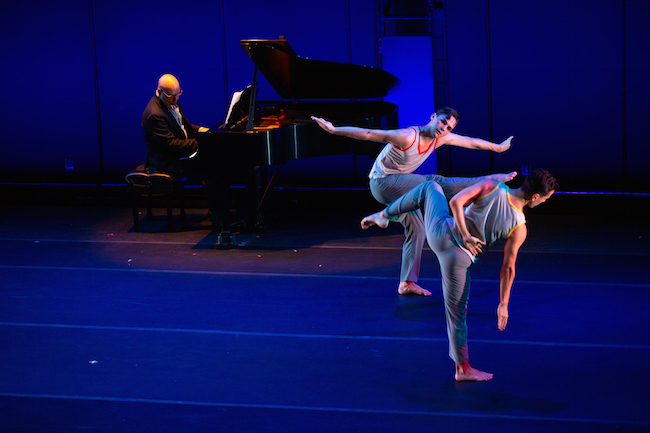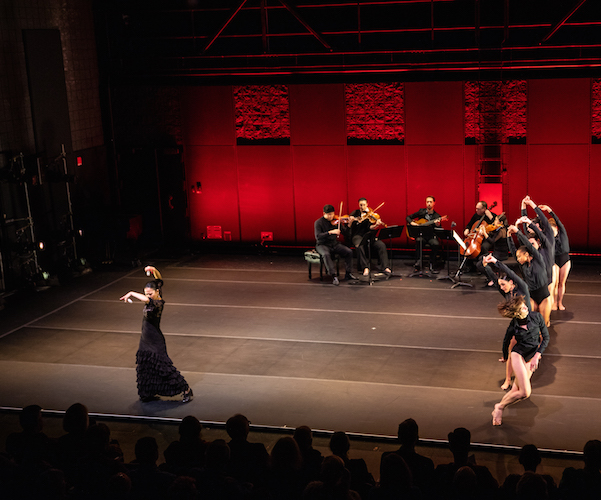Dance Review: Dance Heginbotham — Music Makes It
John Heginbotham may be making modern dance but he gives us the gift of classicism: discovery within form.
Dance Heginbotham, presented by Celebrity Series of Boston, at New England Conservatory’s Plimpton Shattuck Black Box Theater, Boston, MA on November 11.

Victor Lozano and John Eirich in “Easy Win.” Photo: Robert Torres.
By Marcia B. Siegel
John Heginbotham’s Easy Win began with Ethan Iverson playing scales on the piano, in emphatic, marchlike tempo. The dancers made one move per note, and my heart sank. But not for long. Iverson’s composition quickly got denser and more interesting and so did the dance. Using a sturdy noteliness that reminded me of Virgil Thomson, Iverson ramped from scales to counterpoint to waltz-time to blues and ragtime, and back again to a scale at the end. The dancers picked up on all of this, but only in fragments. Instead of trying to illustrate the popular dances Iverson referenced, their movement flowed over the shapes of the music, as if they were internalizing its bumps and sweeps. When the whole group danced, even if they each had a different movement pattern, the whole space was somehow unified.
Easy Win (2015) is an early piece by Heginbotham. He and Iverson saw it as a counterpart to a ballet class — Iverson often accompanies in the studio. But this music is more complex than what the usual classroom improviser comes up with, and Heginbotham’s choreography is detailed, not obsessively metric. The dance is eventful but never random. We start to know the seven dancers and the way Heginbotham works with them. They’re treated as individuals but not in a showy pushy way. They sort themselves out in couples that chase each other and fall headlong on top of one another. John Eirich and Victor Lozano duet, provoking us to wonder whether they’re romantically attracted to each other; they exit without a resolution. As the music winds down in a descending scale, the dancers gather and walk toward the audience, then exit.
After intermission, with the space rearranged upstage for three musicians from the Verona Quartet (Jonathan Ong, violin; Abigail Rojansky, viola; and Jonathan Dormand, cello), we got real romanticism in the form of Ernst von Dohnányi’s Serenade for String Trio. Angels’ Share (2014) began with four dancers joined by a fifth. The main idea may have been about gender, but it may also have been about composition.
Eirich, Lozano, Lindsey Jones and Macy Sullivan began the dance, the men in black tops and white pants, the women in dresses with elongated triangle designs down the front. Not too much later, Courtney Lopes entered, wearing a man’s costume, and she danced with the men when the troops sorted themselves out in male-female groups. At first look, you can’t help thinking of gender distinctions, but these identities didn’t define their movements. Finally, the dance speaks more of how people relate to one another, how they bond through their movements.
Lopes soloed in the second (“Romanza”) movement, stretching and turning, with interruptions by the others. Lindsey Jones and Macy Sullivan danced to the slow fourth movement (“Tema con Variazioni”), with contrasting moves and call-and-response conversations. Their duet could have been a seduction or an essay in composition.
Through the whole dance, the group made itself known, visiting the solo and duet parts, changing partners, clustering in close-linked circles that drew in outsiders. The choreography invokes the music’s themes, showing us the ongoing flow, the interweaving of motifs, but not being didactic about it.
Heginbotham’s musicality asserts itself in an amalgam of modern dance and ballet movement that looks natural even though it’s precisely planned. In Only If You Mean It (2016), Lopes and Sullivan danced to three Heitor Villa-Lobos selections played on the guitar by Jérôme Mouffe. Rather than trying to be as Hispanic-influenced as the music, the dancers used a ballet/modern vocabulary to enact compositional gambits: addressing each other from close up and far away, synchronized turning and jumping, face-to-face encounters. They paid close attention to Mouffe’s soulful slowdowns and sudden buildups. They emphasized the difference in their size, with the diminutive Sullivan exaggerating her shoulder and hip gestures, and Lopes minimizing the same moves by drawing them close in to the body.

Yosi Karahshi and ensemble in “The Fandango.” Photo: Robert Torres.
Finally, Mouffe joined four members of the Verona Quartet for The Fandango (2016), Luigi Boccherini’s Fandango from his Guitar Quintet in D Major. The fandango is a folk dance form where one theme repeats many times with variations. Heginbotham’s dance, for Jones, Lopes, Lozano, Eirich, Sullivan, Amber Star Merkins and Mykel Marai Nairne, didn’t imitate Spanish dance but followed the music’s lively metre with variations and surprises.
Just as I was noting down “surprises,” there was a loud clattering and Yosi Karahashi materialized on stage in a black flamenco dress, wielding white castanets. A four-person “castanet choir” accompanied her from the side aisles. Boccherini’s sedate, almost Baroque beginning proliferated into an organized pandemonium of movement and rhythm.
John Heginbotham started his own dance company in 2011 after dancing for years with Mark Morris. He shares Morris’s love of music but not the literalness Morris sometimes applies to music. Like Morris, he’s worked in different media, his creative gifts already in demand though he’s been choreographing for scarcely a decade.
Sunday’s performance took place in the handsome new black box theater at New England Conservatory and each of the four dances had live musicians. What I appreciated so much about this performance was not only the unfamiliarity of the musical selections but the variety of rhythms and tempos. It’s clear that Heginbotham understands music in terms of human action, not stylistic prescriptions. The heck with labels. Heginbotham may be making modern dance but he gives us the gift of classicism: discovery within form.
Internationally known writer, lecturer, and teacher Marcia B. Siegel covered dance for 16 years at The Boston Phoenix. She is a contributing editor for The Hudson Review. The fourth collection of Siegel’s reviews and essays, Mirrors and Scrims—The Life and Afterlife of Ballet, won the 2010 Selma Jeanne Cohen prize from the American Society for Aesthetics. Her other books include studies of Twyla Tharp, Doris Humphrey, and American choreography. From 1983 to 1996, Siegel was a member of the resident faculty of the Department of Performance Studies, Tisch School of the Arts, New York University. She has contributed two selections to Dance in America, the latest edition in the Library of America’s “Reader’s Anthology” series.

Marcia, I”m so glad I sat in front of you and learned that you would be reviewing the program. Thank you for your expertise and insight. Barbara